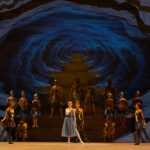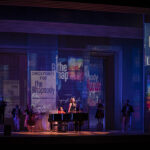Lighting and Projection are Critical for World Premiere
From the enthusiasm in his voice as he drove through Los Angeles, lighting designer Josh Epstein had an unmistakable dose of world premiere fever.
The excitement of being the first-ever designer to conceive the lighting for Other Than Honorable, a new play by stage and screen writer Jamie Pachino, who is known for his work on NBC’s Chicago PD and other projects, had taken hold even before he had seen a single run-through. Epstein had embraced the uncertainty that comes with mounting a world premiere, in which design issues might need to be addressed on the fly as director and playwright made changes to the script before his eyes.

“A lot of times when I’m working, the staging is new, but the text is pretty established,” he says. “Here there’s a bit of evolution with the actual text. That’s a little terrifying, but also exciting — things are changing at a moment’s notice.”
The transitory nature of lighting design lends itself to an environment fueled with change, Epstein noted. “As lighting designers, we create a level of flexibility. It’s the way we work best. Theatre is an always-changing world, but the fact that the text is also changing is a little daunting. That makes working on a world premiere exciting from a design perspective. You’re talking with the author, and you’re putting it on its feet for the first time. That’s thrilling.”

Other Than Honorable got its first production at Geva Theatre Center, a LORT (League of Resident Theatres) professional venue in Rochester, NY, in April and May 2017 amidst a swirl of interest in its crisp writing and headline-inspired themes. In addition to Chicago PD, Pachino’s work is familiar to viewers of Halt and Catch Fire on AMC, Franklin & Bash on TNT and Fairly Legal on USA. Other Than Honorable already won top honors from the John Gassner Playwriting Award Competition, the Gulfshore Playhouse New Works Festival and the Ashland New Plays Festival, as well as the Blue Ink Award from the American Blues Theatre — all before its first production took the stage.
The play’s main character, attorney Grace Rattigan (Jessiee Datino), not only has a staggering case load and a husband deployed in the Middle East, but she must confront her own demons when a young female soldier seeks her out to represent her in a difficult trial. “We often work on plays that have subject matter than is important to this day and age, but I can’t think of a play I’ve worked on that is more timely than this one,” says Epstein. “Talking about women in the military, equality, the treatment of women in and outside of combat and the way we’ve approached integrating women into the military is fascinating.”
At the same time, this play’s staging presents an exciting challenge for a lighting designer — and an opportunity for lighting and projections to work together in a process resembling choreography.
Director Kimberly Senior calls the piece’s rapid pace and clipped presentation of scenes “aggressive precision,” requiring a set that’s always in motion, conceived by scenic designer Jack Magaw. Two turntables — one inside the other — change the scene from one place to another with the silky smoothness of a video edit, while sliding panels allow walls to glide away amid the color and flash of quasi-abstract video projections, creating a new environment in seconds.
This fairly constant motion must be matched with lighting that sustains the sense of movement while making certain that the audience’s attention is guided seamlessly to the next scene. “There’s a lot of technology that is all exciting and interesting, but at the heart of it is trying to tell a complicated story about a really important matter,” says Epstein. “I’m approaching the lighting by trying to distill the location and move the story forward without getting in the way of what’s happening to these characters.”
To accomplish this, however, technology becomes critical. “We’re using everything that Geva has, which is a substantial amount of lighting equipment,” he says. This includes plenty of ETC Source Fours, Vari-Lite VL3000s and VL1000s for moving effects, two Rosco I-Cue Intelligent Mirrors for repositioning beams of light from specific specials and a series of color scrollers that get a significant workout during the performance. Several channels of RC4 wireless dimming provide power and control of the many practical lamps, overhead light fixtures and sconces, virtually all of which come on as they travel on turntables. An ETC Eos lighting control desk controls the entire show.
“Every location has its own look and feel,” Epstein says. “That’s by nature of the fact that it’s a bare stage with a little furniture and some projections on the back wall. So we need to tell a story with the lighting. This becomes as basic as a lamp onstage for a night scene where Grace is sitting in her apartment and as complex as a woman giving testimony while on a moving turntable.”
With two turntables in the mix, the trickiness factor increases. “Some of the action will take place while the set is in motion, which is a more complicated undertaking,” he adds. “We’re going to come to solutions that will take a lot of technical knowhow, but will be seamless. The story is moving ahead in time and space — that’s our challenge. People should walk out feeling like it was a simple production, not thinking about how complicated it is. What we’re attempting is astronomical.”

Balancing Literal and Abstract
In addition to the many moving parts involved in this production, projections play an important role in maintaining the pace. Projections designer Miles Polaski worked closely with Epstein and Magaw to come up with a balance of chaos and control for the visual presentation between scenes.
“The set is very much a deconstruction and a bit of an abstract look at a security fence,” says Polaski by phone three weeks before Other Than Honorable went into tech. “The visual helps extend the metaphor that people in her position had to overcome barriers throughout the play — and through their whole lives.”
Polaski was in Louisville, KY, for the Humana Arts Festival during this conversation, so he was spending time walking the downtown area and shooting photos that could become parts of the Other Than Honorable projections. “I see buildings that have the look and feel that we want,” he says. “But from a projection standpoint, we’re looking at abstracts that denote the locations. We may not even know what we’re going to use until we get into technical rehearsals.”
One thing Polaski did know, however, was that the images would not be overtly military. “Jack Magaw’s set will do a lot of that, and the language of the play is very authoritarian. The language will have a huge impact on creating the structure of the American military. We won’t need to do that with the projections.”
In addition to shooting his own photos and treating them to get the abstracted effect he seeks, Polaski often uses archived photos and video and photos licensed from other photographers. “Say, for a police station,” one of the locations in the play, “there’s an interrogation room. We may see the exterior of a large, industrial, concrete building. At the end of the play, we visit an airport. I love the architecture of airports, when you look up and see all the truss and large pieces of metal that help support these structures — you get a nice, beautiful wall of window glass. We use that, but slightly abstracted, which may mean that we don’t get a clear glimpse — it’s a little blurred, or the angle doesn’t quite give us what we are looking at, but we get the look and feel of it.”

Plot-driven Video
In addition to the scenic elements created by projections, Polaski also has responsibility for a number of videos that advance the plot. Characters involved in building the legal case view videos of depositions from potential witnesses, and these appear above the action, in several squares of the back wall’s mosaic pattern. The effect places the people providing testimony behind a barrier, citing the fence that plays a role in the central conflict.
Grace also plays several scenes with her husband, Billy (John Wernke), over Skype — and Senior and Polaski determined early in the process that these scenes should take place live, rather than pre-recording Billy and having Grace act with a video. “Kimberly and I thought it would be much more interesting to see two live actors speaking with each other, and there would be a lot more energy and growth between them,” says Polaski.
Creating the immediacy of a call from a war zone presented some challenges in both projection and scenic design. “Jack set aside some space in the wings,” Polaski says. “We’ll set up the overseas area with backdrops or panels behind Billy. We’ll have a camera set up there. Kimberly is also interested in projecting Billy onto Grace’s wall in different ways — maybe the screen is smaller the first time he calls, and by the final scene, it becomes much larger.”

The Final Effect
In this play about stark realities, Epstein’s lighting takes a step back from making major artistic statements of its own. Instead, it defines and enhances the transitory acting areas, depending on practicals for warmth while providing the faint fluorescent blues and harsh whites of offices, courtrooms, detention cells, hospitals and an airport.
Epstein counters this with the ambers of home lighting in the intimate scenes between Grace and Billy, using small areas of lighting to emphasize Grace’s loneliness between Skype calls and her desperation as her situation approaches the unbearable. In its restraint, the lighting allows the writing and the actors’ performances to propel the message forward.
It’s unlikely that audiences will indeed see this production as simple either in content or scope, but the lighting and projections achieved the seamlessness the designers and director sought. More important, this will not be the last we will see of this electrifying play and its searing subject matter. Other Than Honorable is a play to watch for as it moves forward in its rise to national attention.


